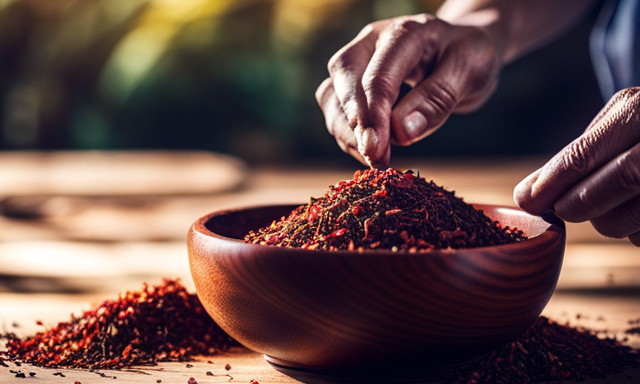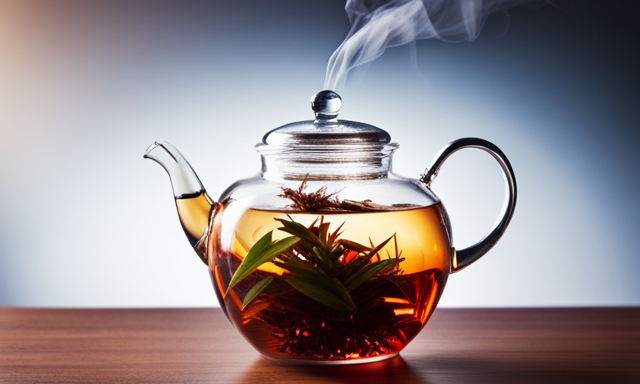In the vast world of tea, there is one variety that stands out like a beacon of warmth and comfort: rooibos. As I take my first sip of this golden-hued elixir, a wave of familiarity washes over me, like coming home after a long journey.
The taste of rooibos is a symphony of flavors, a delicate balance between earthiness and sweetness. It is as if the sun-kissed plains of South Africa have been captured in each fragrant leaf.
Rooibos is unlike any other tea I have encountered. Its distinctive flavor profile sets it apart from its counterparts, infusing each cup with a rich complexity that is both soothing and invigorating. With its smooth and velvety texture, rooibos caresses the palate, leaving a lingering sweetness that dances on the taste buds.
But rooibos is not just about taste; it is also about wellness. Packed with antioxidants and a myriad of health benefits, this remarkable tea is a true gift from nature. Whether enjoyed on its own or blended with other ingredients, rooibos is a versatile companion for any tea enthusiast.
Join me on a journey of exploration as we delve into the world of rooibos, uncovering its secrets, and discovering the unparalleled pleasure it brings to our senses.
Key Takeaways
- Rooibos has a sweet, nutty, and slightly earthy flavor profile.
- It can be compared to mild black tea without bitterness or astringency.
- Rooibos is a caffeine-free alternative to tea or coffee.
- It can be enjoyed plain or with milk or honey, but it is recommended to taste it on its own first.
Origin and History of Rooibos
Rooibos, also known as red bush tea, has a fascinating origin and history. Its story begins in the Cederberg region of South Africa, where the plant grows naturally and has been used for centuries by the indigenous Khoi and San peoples. The origin of rooibos can be traced back to these ancient cultures who discovered its medicinal properties and cultural significance.
The Khoi and San would brew the leaves to make a refreshing and nourishing infusion that became an integral part of their daily lives. Over time, rooibos gained popularity beyond the indigenous communities and became a sought-after commodity worldwide. Today, it is enjoyed by millions for its distinctive flavor profile and numerous health benefits.
Transitioning into the subsequent section about the tea’s distinctive flavor profile, rooibos leaves are known for their unique taste and aroma.
Distinctive Flavor Profile
Indulge in the unique flavor profile of rooibos, and experience a taste that transports you to a world of warmth and earthy sweetness. Rooibos is known for its distinct flavor notes, which combine elements of honey, vanilla, and caramel, resulting in a smooth and mellow taste. Its natural sweetness is balanced by a subtle nuttiness and a hint of floral undertones.
Unlike traditional teas, rooibos lacks the astringency and bitterness commonly associated with black or green tea varieties. It offers a soothing and comforting experience, reminiscent of a cozy autumn day. Comparatively, while black tea may possess a robust and bold flavor, and green tea a grassy and vegetal taste, rooibos stands apart with its unique blend of flavors.
Transitioning to the next section, let’s explore how rooibos compares to other tea varieties.
Comparison to Other Tea Varieties
Sip on this warm and earthy brew and you’ll find that its distinctive flavor sets it apart from other tea varieties. Rooibos, also known as red bush tea, offers a unique taste that cannot be replicated by black tea or green tea.
To better understand the differences, let’s take a closer look at the flavor profiles of each type of tea.
| Tea Variety | Flavor Profile |
|---|---|
| Rooibos | Warm, nutty, and slightly sweet |
| Black Tea | Bold, robust, and often astringent |
| Green Tea | Fresh, grassy, and sometimes slightly bitter |
While black tea boasts a strong and robust flavor, rooibos provides a more delicate and nutty taste. In contrast, green tea offers a crisp and refreshing flavor that can sometimes be bitter.
As we transition into the next section about the health benefits of rooibos, it is important to note that its unique flavor is not the only thing that sets it apart from other teas.
Health Benefits of Rooibos
Get ready to discover the amazing health benefits that rooibos brings to your daily routine! This South African herbal tea not only offers a delightful taste but also boasts an impressive array of nutritional properties.
Rooibos is rich in antioxidants, which play a crucial role in combating free radicals and reducing oxidative stress in the body. These antioxidants help boost the immune system, promote healthy skin, and may even have anti-inflammatory effects.
Additionally, rooibos is free from caffeine, making it a great choice for those looking to reduce their caffeine intake.
Now that we’ve explored the health benefits of rooibos, let’s delve into the world of rooibos blends and infusions, where you’ll discover even more exciting flavors and aromas.
Rooibos Blends and Infusions
Explore the world of rooibos blends and infusions, where you’ll uncover an array of exciting flavors and aromas to tantalize your taste buds.
Not only does rooibos offer numerous health benefits, but it also lends itself to a variety of delightful flavor combinations. From fruity infusions like rooibos mixed with citrus or berries, to more complex blends incorporating spices like cinnamon and ginger, there is something for everyone.
The natural sweetness of rooibos pairs perfectly with the tartness of fruits, creating a harmonious balance of flavors. Additionally, the earthy undertones of rooibos create a rich base for the addition of spices, resulting in a warming and comforting cup of tea.
Discover the endless possibilities of rooibos blends and infusions, and prepare to embark on a journey of taste and aroma.
Now, let’s delve into the art of brewing techniques for rooibos.
Brewing Techniques for Rooibos
Experience the full-bodied richness and aromatic bliss of a perfectly brewed cup of rooibos tea with these expert brewing techniques. When it comes to rooibos, the key is to find the balance between extracting the flavor notes and avoiding any bitterness. Start by using freshly boiled water and steeping the tea for five to seven minutes. This allows the earthy, sweet, and slightly nutty flavors to fully develop. For a stronger brew, extend the steeping time. To enhance the taste, you can also experiment with adding a dash of honey or a slice of lemon.
Once brewed, the vibrant red hue of the tea is a feast for the eyes.
Transitioning into serving suggestions and pairings, the bold flavors of rooibos make it a perfect accompaniment to dark chocolate or spiced desserts.
Serving Suggestions and Pairings
Indulge your taste buds with the perfect accompaniment to rooibos tea – dark chocolate or spiced desserts. These rich and decadent treats perfectly complement the earthy and slightly sweet flavor of rooibos. Here are some serving ideas and flavor pairings to enhance your rooibos experience:
-
Enjoy a slice of moist chocolate cake with a steaming cup of rooibos for a delightful combination of flavors.
-
Pair rooibos with a warm apple pie or cinnamon-infused pastries for a cozy and comforting treat.
-
For a unique twist, try serving rooibos with a spiced pumpkin cheesecake to bring out the warm and aromatic notes in both.
-
Indulge in a rich chocolate mousse alongside a cup of rooibos for a truly indulgent dessert experience.
-
For a lighter option, pair rooibos with a lemon tart or citrus-infused desserts to create a refreshing and tangy contrast.
Now that we’ve explored serving suggestions and flavor pairings, let’s move on to the next section about the availability and where to buy rooibos.
Availability and Where to Buy Rooibos
Rooibos tea is as easy to find as a needle in a haystack, with countless online retailers and local grocery stores stocking this South African delight. Its availability has soared in recent years, making it a popular choice for tea enthusiasts worldwide.
When it comes to online options, there’s an abundance of websites that offer a wide selection of rooibos teas, ranging from traditional blends to unique flavors. These online retailers often provide detailed descriptions and customer reviews, allowing you to make an informed decision before purchasing.
Additionally, local grocery stores now recognize the demand for rooibos tea and frequently carry a range of options. With the convenience of online shopping and the accessibility of local stores, getting your favorite rooibos tea has never been easier.
As we delve into frequently asked questions about rooibos, let’s explore its health benefits and brewing techniques.
Frequently Asked Questions about Rooibos
Discover the most frequently asked questions about rooibos and gain a deeper understanding of its health benefits and brewing techniques.
-
What does rooibos taste like?
Rooibos has a unique flavor profile that can be described as naturally sweet, nutty, and slightly earthy. It’s often compared to a mild black tea, but without the astringency or bitterness. -
Can I add milk or sweeteners to rooibos?
While it’s traditionally enjoyed plain, rooibos can be enhanced with a splash of milk or a touch of honey if desired. However, it’s recommended to taste it on its own first to fully appreciate its natural taste. -
Does rooibos have caffeine?
No, rooibos is naturally caffeine-free, making it an excellent choice for those seeking a caffeine-free alternative to tea or coffee. -
Can I drink rooibos hot or cold?
Absolutely! Rooibos can be enjoyed hot or cold, depending on your taste preferences and the weather. It is delicious both ways.
Transition: Now that we’ve explored the frequently asked questions about rooibos, let’s move on to the conclusion and delve into the rich flavors that this amazing tea has to offer.
Conclusion: Explore the Rich Flavors of Rooibos
Immerse yourself in a world of rich flavors as you savor the diverse taste sensations that rooibos has to offer. Rooibos, also known as red bush tea, is a versatile and intriguing beverage that captivates the palate with its unique taste profile. With its earthy undertones and naturally sweet notes, rooibos provides a delightful and refreshing experience with every sip.
As you embark on a taste exploration of rooibos, you will encounter a myriad of flavors that range from fruity and floral to woody and nutty. This sensory journey will transport you to the vast landscapes of South Africa, where rooibos is grown and harvested.
To further evoke an emotional response, allow me to present a table that showcases the various flavor profiles found in rooibos:
| Flavor | Description |
|---|---|
| Fruity | Bursting with vibrant fruitiness |
| Floral | Delicate and aromatic |
| Woody | Earthy and robust |
| Nutty | Smooth and subtly nutty |
| Sweet | Naturally sweet and comforting |
Indulge in the complexity of rooibos and let your taste buds guide you through this exceptional tea. Explore the flavors that intrigue you the most and uncover the true essence of rooibos.
Frequently Asked Questions
How is rooibos different from other herbal teas?
Rooibos, unlike other herbal teas, boasts unique health benefits and a distinct flavor profile. Its antioxidant properties promote overall well-being, while its naturally sweet and nutty taste offers a delightful and refreshing experience.
Can rooibos be enjoyed hot as well as iced?
Yes, rooibos can be enjoyed both hot and iced. I love exploring hot rooibos recipes like chai or vanilla-infused. Additionally, the benefits of drinking iced rooibos are its refreshing nature and potential to provide hydration and antioxidants.
Is rooibos naturally caffeine-free?
Rooibos is naturally caffeine-free, making it a safe choice for pregnant women. It offers numerous health benefits, such as being rich in antioxidants and aiding in digestion. Now, let’s explore the taste of rooibos.
Can rooibos help with digestion or stomach issues?
Rooibos has numerous benefits for gut health. Its anti-inflammatory properties can help with digestion and alleviate stomach issues. It is known to soothe the digestive system and promote a healthy gut microbiome.
Are there any potential side effects or allergies associated with rooibos consumption?
There are no known allergies or major side effects associated with rooibos consumption. However, it is always important to consult with a healthcare professional before making any dietary changes. Rooibos tea is prepared by steeping the leaves in hot water for a few minutes. It is known for its potential health benefits, including its high antioxidant content and anti-inflammatory properties.
Conclusion
As I sip the last remnants of my warm cup of rooibos, I can’t help but marvel at the contrasting flavors that danced on my palate. The sweet, nutty notes blended seamlessly with the subtle hints of vanilla, creating a symphony of taste.
Rooibos, with its rich history and health benefits, is truly a hidden gem in the world of tea. So why settle for ordinary when you can indulge in the extraordinary? Treat yourself to the unique and exquisite flavors of rooibos, and embark on a journey of sensory delight.










